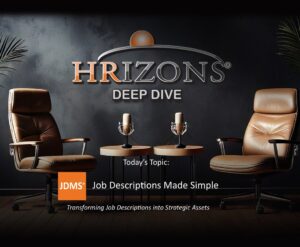The Gallup Organization over the years has interviewed more than 25 million employees, asking them each hundreds of questions related to employee engagement. Eventually they boiled these down to 12 questions which measure the core elements (strengths) of a workplace that attract, focus, and retain the most talented employees.
Not unexpectedly, the top question is “Do I know what is expected of me at work?” Of course it is the hiring manager’s responsibility to make those expectations clear and to ensure that alignment of expectations continues as the person and position develop. But how do we, as organizations continue to communicate expectations to employees? The answer seems obvious: Job Descriptions. With job description management, you can take control over the future of your company’s employment and expand your reach to job seekers.
Don MacPherson of Modern Survey makes this important point about job descriptions and employee performance and engagement:
“Every job has meaning otherwise it shouldn’t exist. Every employee should know the importance of their job. If they don’t know the value they bring to their organization, their leader should help them realize the link between their activities and the organization’s goals.”[1]
HR Recruiters and hiring managers understand how externally posted job descriptions can be tools to attract top talent. Yet these same managers and HR business partners too often fail to use their internal job descriptions as tools to engage and retain valued employees. After they’ve hired the talent, the compliance mindset often takes over and job descriptions are reduced to compliance enforcement tools. The transformative potential for talent management is lost.
There are many studies that demonstrate the importance of good job design for increasing the employees’ experience of meaning and engagement in their work. Employees need clear, outcome-based job descriptions to see how their jobs contribute to the bigger picture. This is especially true for the millennial generation who want to experience greater meaning in their work and opportunities for career advancement. Well-designed job descriptions clearly communicate how each employee contributes value and can continue to grow within the organization.
So why aren’t job descriptions being used more as engagement and retention tools?
We already suggest one main reason: the compliance mindset predominates in job description management at the expense of the talent mindset. Compliance is of course extremely important; but not to the exclusion of talent management. Another key reason is the lack of easy-to-use technologies to enable managers and employee to modify, access, and integrate job descriptions in their regular performance coaching and career development activities. Job description management still typically resides with HR recruitment and compensation, and primarily in Word docs that are rarely viewed by managers or employees (except when hiring).
Leading talent-minded organizations are breaking with this traditional pattern and seeing the value of online job description management solutions to empower engagement, performance, and retention of valued employees. Job description content is being synchronized with talent management processes and HCM technologies: from recruitment to onboarding; performance management to career development; learning to workforce and succession planning. Leading healthcare organizations are implementing innovative technology solutions to integrate job descriptions with performance management. Technology companies such as SAP/SuccessFactors and HRIZONS are providing solutions to turn conventional job descriptions into powerful communication tools for organizational transformation.
organizations are implementing innovative technology solutions to integrate job descriptions with performance management. Technology companies such as SAP/SuccessFactors and HRIZONS are providing solutions to turn conventional job descriptions into powerful communication tools for organizational transformation.
What is your organization doing to move beyond the compliance mindset?
Contact HRIZONS for information about job description management solutions that can support employee engagement, retention and related talent management functions.
[1] http://www.modernsurvey.com/blog/employee-engagement-personal-accomplishment




